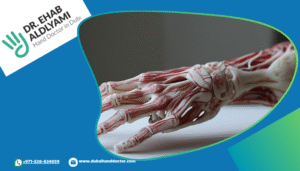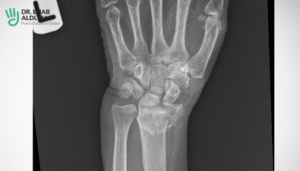Understanding Nerve compression in the hand and wrist: From tingling to treatment

Are you experiencing persistent tingling, burning, or numbness in your hand or wrist?
These could be early warning signs of nerve compression syndrome, a condition that develops when a nerve becomes compressed or irritated along its path. This common yet often overlooked issue can gradually worsen if not addressed.
In this blog, we’ll explore the types, symptoms, causes, and diagnosis of nerve compression syndrome to help you better understand what’s behind the discomfort—and when to seek help.
Understanding Nerve Compression Syndrome
Nerve compression syndrome happens when a nerve is compressed, pinched, or irritated by surrounding tissues such as bones, muscles, tendons, or cartilage.
This compression can interfere with the nerve’s normal function, leading to pain, tingling, numbness, or muscle weakness, especially in the hand and wrist.
Types of nerve compression syndrome
- Carpal tunnel syndrome – Stems from the compression of median nerve at the wrist, causing weakness, numbness, and tingling sensations in the thumb, index and middle fingers.
- Cubital tunnel syndrome – Results from the pressure on the ulnar nerve at the elbow, causing tingling, numbness, or reduced strength in the ring and little fingers.
- Radial nerve compression syndrome – Occurs when the radial nerve is compressed in the forearm, often causing pain, weakness, or difficulty extending the wrist and fingers.
- Ulnar tunnel syndrome – Results from the compression of the ulnar nerve at the wrist, causing numbness and weakness in the ring and little fingers, especially during gripping activities.
Symptoms of nerve compression syndrome
The symptoms of nerve compression syndrome may develop gradually and worsen over time, especially with continued pressure or repetitive movements:
- Redness, swelling, and inflammation
- Burning or radiating pain in fingers and hands
- Tingling or numbness in the hand
- Weakness in the hand or fingers
- Clumsiness or loss of coordination
- Reduced flexibility
- Difficulty with certain movements
Causes of nerve compression syndrome
Nerve compression syndromes in the hand and wrist occur when a nerve is pinched or irritated by surrounding structures such as bones, muscles, tendons, or ligaments.
Several factors can contribute to nerve compression:
- Repetitive hand or wrist movements
- Prolonged pressure on the wrist or elbow
- Fractures, sprains, or direct impact to the wrist or elbow
- Arthritis or joint inflammation
- Cysts or tumors
- Diabetes or metabolic conditions
Nerve compression syndrome diagnosis
Dr. Ehab Aldlyami will begin by evaluating your symptoms, followed by a physical examination to check for signs of nerve compression.
Some tests used to diagnose nerve compression syndrome include:
- Nerve conduction studies
- Electromyography (EMG)
- X-ray
- Magnetic Resonance Imaging (MRI)
For carpal tunnel or cubital tunnel syndrome, these diagnostic tests may not always be necessary, but can still offer valuable insights, particularly when symptoms are unclear or treatment planning is needed.
Treatment options for nerve compression syndrome
Treatment for nerve compression syndrome focuses on relieving pressure on the affected nerve, minimize inflammation, and restoring normal nerve function.
The treatment approach depends on the severity, duration, and location of the compression:
Lifestyle changes
Making simple adjustments—such as avoiding repetitive hand motions, improving posture, using ergonomic tools, or taking regular breaks—can reduce strain on the nerves and prevent symptoms from worsening.
Physical therapy
Guided exercises and stretching can help improve flexibility, reduce stiffness, and restore range of motion. Nerve gliding exercises are often used to promote healing and prevent further irritation.
Medications
- Nonsteroidal anti-inflammatory drugs (NSAIDs) like ibuprofen help reduce pain and inflammation.
- In some cases, corticosteroid injections may reduce swelling around the nerve.
Prosthetic devices
Wearing a wrist splint (especially at night for carpal tunnel syndrome) and elbow brace (for cubital tunnel syndrome) can keep the joint in a neutral position and relieve nerve pressure during rest.
Surgery
If conservative treatments fail or if there’s severe compression with muscle weakness or nerve damage, surgery may be necessary.
Common surgical procedures include:
- Carpal tunnel release (performed to relieve pressure on the median nerve)
- Ulnar nerve decompression or transposition (for cubital or ulnar tunnel syndrome)
Expert nerve compression syndrome treatment in Dubai – Dr. Ehab Bassim Aldlyami
Nerve compression syndrome in the hand and wrist can significantly impact your quality of life—from work tasks to daily activities.
If you’re experiencing persistent numbness, tingling, weakness, or pain, consulting Dr. Ehab Bassim Aldlyami is the first step toward lasting relief. With advanced diagnostic tools and a tailored treatment approach, Dr. Ehab offers compassionate care to help you regain comfort, strength, and control.

Related Post

مدة علاج العظم الزورقي: كل ما تحتاج معرفته عن علاج كسر العظم الزورقي
العظم الزورقي هو أحد العظام الصغيرة الموجودة في اليد التي تقع في المعصم. بالرغم من

اعراض وعلاج تمزق اربطة اليد
تمثل اليد أحد أكثر أجزاء الجسم استخدامًا في الحياة اليومية، مما يجعلها عرضة للإصابات

Scaphoid fracture: Causes, symptoms & treatment options
In the world of hand and wrist injuries, few conditions are as deceptively subtle yet

What to Know About a Distal Radius Fracture: Causes, Symptoms & Treatment
The distal radius fracture is the most common broken wrist. It can follow a simple

5 Common Hand Disorders & Their Treatments
Our hands play an essential role in nearly every task we do, from simple daily

Hand Pain Isn’t Always What It Seems: Insight from a Doctor
We use our hands for nearly everything — from sending texts to cooking dinner or




